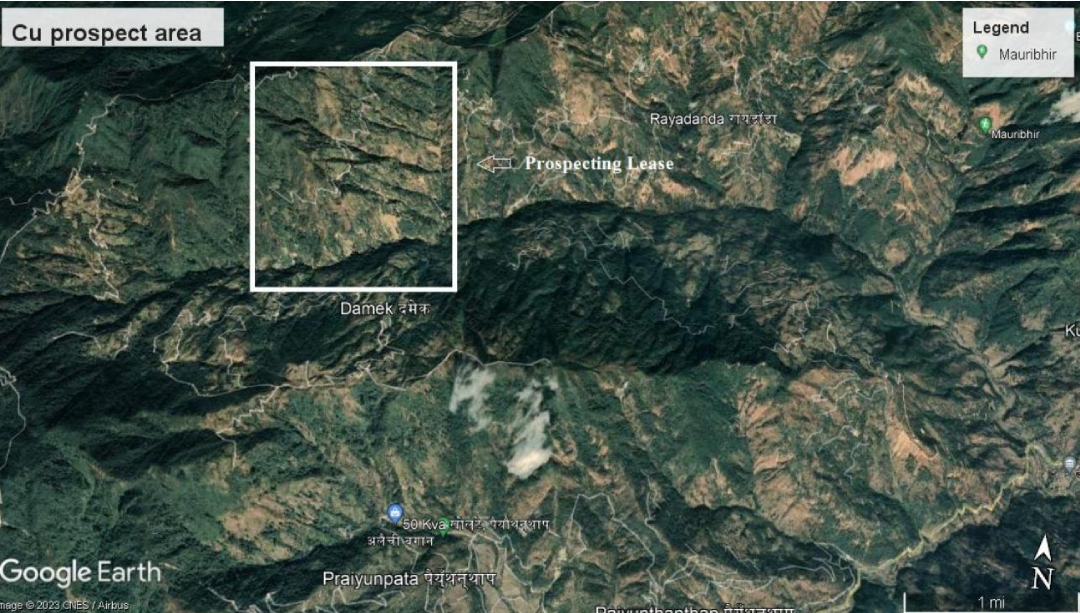Dhaulagiri Copper Mine
Background
Copper is an element and a mineral. It is found in the oxidized zones of copper deposits; in hydrothermal veins; in the cavities of basalt that have been in contact with hydrothermal solutions; and as pore fillings and replacements in conglomerates that have been in contact with hydrothermal solutions. It is rarely found in large quantities; thus it is seldom the primary target of a mining operation. Most copper produced is extracted from sulfide deposits. Copper is an excellent conductor of electricity. Most copper mined today is used to conduct electricity - mostly as wiring. It is also an excellent conductor of heat and is used in cooking utensils, heat sinks, and heat exchangers. Large amounts are also used to make alloys such as brass (copper and zinc) and bronze (copper, tin, and zinc). Copper is also alloy with precious metals such as gold and silver. copper was probably one of the early metals worked by ancient people. Nuggets of the metal could found in streams in a few areas, and its properties allowed it to be easily worked without a required processing step. Copper's metallic luster attracted people's attention. Today most copper is produce from sulfide ores. Most nonrecycled supplies come from porphyry copper deposits (PCDs), which form when hot, metal-bearing fluids percolate up through Earth's crust. These fluids bubble up through the crust and collect in pores in the rock, where they sit, waiting for the final step that will allow them to form copper minerals. The major ores of the copper are Chalcopyrite, Chalcocite, Covelite, Bornite.
Most copper is use in electrical equipment such as wiring and motors. This is because it conducts both heat and electricity very well, and can be drawn into wires. It also has uses in construction (for example roofing and plumbing), and industrial machinery (such as heat exchangers). Kitchen Sink. - Copper is a good choice for kitchen sink because it is generally resistant to corrosion and it has anti-microbial properties. The uses of the copper are Table Tops, Jewellery, Door Knobs and Pull Handles, Railings, Tool, Musical Instruments Wire.
M/S Muheng Minerals Pvt. Ltd has b e e n awarded a prospecting license of copper ( license no: 83/079/80: dated: 2079/12/29) at Damek area of Jaimuni Municipality (Previous: Damek VDC) Baglung District, Gandaki Province, Nepal from department of mines and geology in an area of 4 square kilometers.


Location of Lease Area
Toposheet no. 2883 15 A (1:25,000 scale),
Gandaki Province, Dhaulagiri Zone, Baglung District, Jaimuni Municipality.
Main point location: a spot height of 2323 m as a main point (coordinate 454375.00 m. East, 3120312.50 m. North)
Demarcation of Lease Area: From the main point, East 1625 m, west 375 m, north 687.50 m, and south 1312.50 m, total area of 4.00 sq. km.


Mineralization
Malachite staining has developed in phyllite of Galyang (GI) rock type. Malachite and azurite are formed in the weathering zone of copper mineralization normally of chalcopyrite. So they are indicator of possible mineral occurrences underneath.

Based on the quick surface observation, it is assumed the average thickness 5m, extended length along strike direction about 400m and depth extension of 200m, mineralized body volume comes about 400000 m3. Expected average copper grade is about 1% and specific gravity 4 ton/m3. On this basis 1.6 million ton of 1% copper grade deposit could be possible.
